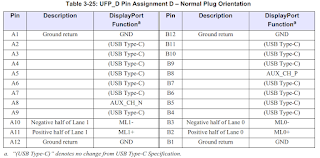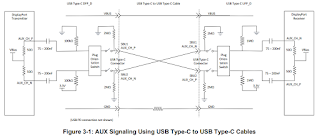This section describes the cable assemblies and adapters used for DisplayPort signaling through
a USB Type-C connector.
4.1 Scenario 1 USB Type-C Cable
Figure 4-1 illustrates an example of a USB Full-Featured Type-C cable assembly (as defined in USB Type-C Specification) used for DisplayPort.
4.1.1 Scenario 1 USB Type-C Cable Using GEN2_BR
This scenario uses DFP_D Pin Assignment A at the DisplayPort Source device and UFP_D Pin
Assignment A at the DisplayPort Sink device.
- Figure 4-2 illustrates when the plugs at both ends are inserted in normal orientation
- Figure 4-3 illustrates when the DFP_D plug is flipped and the UFP_D plug is inserted in normal orientation
- Figure 4-4 illustrates when the DFP_D plug is inserted in normal orientation and the UFP_D plug is flipped
- Figure 4-5 illustrates when the plugs at both ends are flipped
4.1.2 Scenario 1 USB Type-C Cable Using DP_BR
This scenario uses DFP_D Pin Assignment C at the DisplayPort Source device and UFP_D Pin
Assignment C at the DisplayPort Sink device.
4.2 Scenarios 2a and 2b USB Type-C to DisplayPort Cable
The same USB Type-C to DP cable supports both Scenario 2a (USB Type-C DFP_D
to DisplayPort UFP_D) and Scenario 2b (DisplayPort DFP_D to USB Type-C UFP_D).
4.2.1 Scenario 2a USB Type-C DFP_D to DisplayPort UFP_D
- 如果沒有成功進到Alt Mode, 則必須要顯示USB Billboard board告知end-user狀況
- The cable assembly’s connections behind pins A10, A11, B10, and B11 on the USB Type-C Plug shall contain series AC capacitors as specified in DP Standard (75 to 265nF), because these pins are required to be AC-coupled at the DFP_D by DP Standard, but are DC-connected in the system behind the USB Type-C receptacle.
4.2.2 Scenario 2b DisplayPort DFP_D to USB Type-C UFP_D
- This scenario uses UFP_D Pin Assignment E.
- The cable assembly is the same cable assembly that used in Scenario 2a, but with DisplayPort signaling running in the opposite direction.
- Pins A10, A11, B10, and B11 are DC-coupled in the system behind the USB Type-C receptacle; thus, the capacitors on these pins provide the optional AC-coupling permitted by DP Standard.
4.2.4.2 DisplayPort DFP_D/UFP_D Detection and HPD Signaling
DP Standard defines pull-up and pull-down resistors for the AUX_CH_P/AUX_CH_N signal pair at both DisplayPort DFP_D and DisplayPort UFP_D, between the AC-coupling capacitors.
The behavior of DP(DFP_D) to C (UFP_D)
- 當Adapter的SBU2從open變成logic 1時,代表DFP_D已連接Adapter,此時可透過DP status update告知此狀態並等待DP configure command ; 當接收到DP configure command後(表示Type-C端已切換成UFP_D),Adapter需將開關短路(此時AUX相通),而UFP_D(Type-C端)必須透過PD messages向Adapter回報HPD狀態,Adapter再根據HPD狀態控制HPD訊號供DFP_D偵測。如果DFP_D斷開連接(此時AUX_P會回復logic 1,AUX_N會回復logic 0),Adapter需要透過PD messages向Type-C端(UFP_D)回報DFP_D已斷開,並將SBU開關關閉(SBU恢復open狀態)
The behavior of C(DFP_D) to DP(UFP_D)
※ 某些顯示器(螢幕)沒有在AUX_P放pull-up電阻,而是透過HPD拉high的方式
- 當Adapter的SBU1從open變成logic 1或是HPD訊號變化,代表UFP_D已經接上Adapters。此時可透過PD messages (DP Attention)回報UFP_D已連接,並等待DP Configure command;當接收到DP configure command(表Type-C端為DFP_D)後,Adapter需將AUX開關開啟(此時AUX相通),UFP_D就可以透過AUX偵測DFP_D已存在。Adapter必須透過PD messages提供HPD狀態給DFP_D。如果UFP_D斷開連接(此時HPD變成low),Adapter必須透過PD messages向DFP_D回報UFP_D已斷開,並將SBU開關關閉(恢復open狀態)
4.3 Scenarios 3a and 3c USB Type-C DFP_D to Protocol Conver
- These scenarios use DFP_D Pin Assignment C. The implementation of AUX signaling and HPD the Protocol Converter is similar to that used in a USB Type-C UFP_D (see Section 3.15).
- HDMI Protocol Converters
- HDMI Protocol Converters shall support four HBR2 lanes.
- In addition, the DETAILED_CAP_INFO_AVAILABLE bit in the DOWN_STREAM_PORT_PRESENT register (DPCD Address 00005h, bit 4) shall have a value of 1 (i.e., the DFP_D Receiver Capability fields in registers starting at DPCD Address 00080h shall use the longer four-byte format).
The following features, optional in DP Standard, shall be supported:
- 594M characters per second per channel
- 4K at 60Hz YCbCr 4:4:4, as specified in HDMI v2.0b
- HDMI Sink maximum character per channel rate indication
- HDMI Sink Error status
- CEC, including low-power management and CEC-Tunneling-over-AUX with support for snooping and multiple-logical addresses
- Pass-through of YCbCr 4:2:0 color format
- Conversion from YCbCr 4:4:4 format or YCbCr 4:2:2 format to YCbCr 4:2:0
- Generation of an IRQ_HPD on HDMI status changes
- HDCP v1.4 and HDCP v2.2 on the USB Type-C connection
- HDCP v1.4 and HDCP v2.2 on the HDMI connection
- Conversion from DP Frame Sequential to HDMI Frame Pack 3D format
- HDCP v2.2 repeater
2. VGA Protocol Converters
VGA Protocol Converters shall support a minimum resolution of 1920x1200 at 60Hz, 24bpp
reduced blanking, 1600x1200 at 60Hz, 24bpp full blanking. VGA Protocol Converters shall
support at least one HBR2 lane.
3. DVI Protocol Converters
Single-link DVI Protocol Converters shall support a minimum resolution of 1920x1200 at 60Hz,
24bpp. DVI Protocol Converters shall support two HBR lanes, but are not required to support
bandwidths in excess of two HBR lanes.
4.4 Scenario 4a USB Type-C DFP_D to a Multi-function Dock
This scenario uses DFP_D Pin Assignment B at the DisplayPort Source device and UFP_D Pin
Assignment B at the DisplayPort Sink device. In the event that the Multi-function dock can be
configured to apply all four DisplayPort lanes to the DisplayPort connector, Pin Assignment A is
used instead.
- The Multi-function dock shall contain a DisplayPort Branch device that can adapt from GEN2_BR to DP_BR on the DisplayPort connector.
4.4.2 Scenario 4a USB Type-C Cable Using DP_BR Multi-function
This scenario uses DFP_D Pin Assignment D at the DisplayPort Source device and UFP_D Pin
Assignment D at the DisplayPort Sink device. In the event that the Multi-function dock can be
configured to apply all four DisplayPort lanes to the DisplayPort connector, Pin Assignment C
is used instead.
4.5 Scenarios 4c and 4d USB Type-C DFP_D to Multi-function Cradle/Captive Cable Dock
Figure 4-32 illustrates a USB Type-C DFP_D connected to a Multi-function cradle dock.
Figure 4-33 illustrates a USB Type-C DFP_D connected to a Multi-function Captive cable dock.
- Scenarios 4c and 4d USB Type-C DFP_D to Multi-function Cradle/Captive Cable Dock Using GEN2_BR
These scenarios use DFP_D Pin Assignment B at the DP Source device.
- Scenarios 4c and 4d USB Type-C DFP_D to Multi-function radle/Captive Cable Dock using DP_BR
Reference:
1. VESA DisplayPort Alt Mode on USB Type-C Standard (DisplayPort Alt Mode), Version 1.0b, Draft
2. VESA - DisplayPortTM Alternate Mode on USB-CTM - Technical Overview




















































